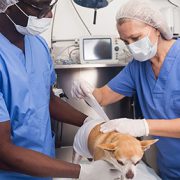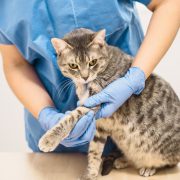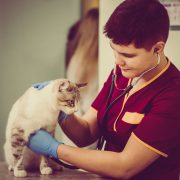Partial weight reduction protocols in cats lead to better weight outcomes, compared with complete protocols, in cats with obesity
Partial weight reduction protocols in cats lead to better weight outcomes, compared with complete protocols, in cats with obesity

Open access
In our edition of: Aug 2023
In our categories of: small animals
our summary:
German, A.J. et al. (2023) Partial weight reduction protocols in cats lead to better weight outcomes, compared with complete protocols, in cats with obesity. Frontiers in Veterinary Science, 10, 1211543
The aim of this non-randomised observational cohort study was to compare outcomes in cats undergoing complete versus partial weight reduction protocols, including rate of weight loss and changes in body composition. An additional aim was to assess essential nutrient intakes during weight reduction.
The research was carried out as a collaboration between researchers at the University of Liverpool and Royal Canin (RC), the manufacturers of the food, who also funded the study.
The study included 46 (79%) and 12 (21%) cats that underwent complete or partial weigh reduction protocols respectively, at the Royal Canin Weight Management Clinic at the University of Liverpool, between January 2005 and July 2021.
All cats underwent a health assessment including routine blood and urine samples, body condition scoring (BCS) and, in most cases, dual-energy X-ray absorptiometry (DEXA) to assess body composition. These tests were repeated when the cats reached their target weight.
In the complete weight reduction protocol, the primary aim was to return the cat to within ±5% of their ideal weight, while the partial weight reduction protocol accepted that cats would still be in overweight body condition (i.e., at least 10% above their ideal weight) at the end of their protocol. The reasons for choosing partial weight reduction included age (> 9 years, 3 cats) and marked obesity (> 40% above ideal weight, 2 cats) or both (7 cats).
Ideal weight was defined as the weight at which the cat’s body fat mass was optimal as defined by DEXA or BCS. When body composition data was not available, ideal weight was calculated from the starting weight of the cat divided by 1.2, 1.3, or 1.4 for cats with BCS of 7, 8 and 9 respectively.
Cats were fed on commercially available weight reduction diets (RC Obesity Management or Satiety Support) and owners were given advice on how to stimulate physical activity. Owners were asked to maintain a diary of food intake and physical activity and the cats were checked every 2-4 weeks.
The intake of essential nutrients was estimated from the average daily food intake and the nutrient content of the therapeutic diet as reported by the manufacturer and compared to published recommendations (NRC 2006; FEDIAF 2021).
The percentage bodyweight lost was 23% (10-39%) over 294 (113-967) days, for the cats on the complete weight reduction programme, and 25% (10-41%) over 178 (54-512) days on the partial weight loss. Significant decreases were seen in all cats for total mass, fat mass, fat % and bone mineral mass. However, although lean mass decreased significantly for cats on the complete weight reduction programme, there was no change in lean mass for cats undergoing partial weight reduction.
The daily recommended intakes were met for most essential nutrients, and where the requirements were not met (choline, selenium, potassium, and phenylalanine/tyrosine) intake was close to the recommended amount. None of the cats showed any signs of nutrient deficiency.
Limitations included the small number of cats in the partial weight reduction programme, the fact that the study populations were different and from a specialist referral obesity clinic, which may not represent cats seen in general practice. In addition only four diets from a single manufacturer were assessed, so the results may not be generalisable to other weight reduction diets.
This paper provides some evidence that partial weight reduction protocols can lead to successful weight loss in cats, including those that are severely obese and those that are older, and may help to preserve lean tissue. The increased average rate of weight loss and reduced timescale may be more acceptable to clients and may be a suitable compromise to maximise the chance of successful weight loss.
The following may also be of interest:
Keller, E. et al. (2020) Use of reduced-energy content maintenance diets for modest weight reduction in overweight cats and dogs. Research in Veterinary Science, 131, pp. 194-205 https://doi.org/10.1016/j.rvsc.2020.04.019
The August 2020 edition of inFOCUS contains a summary of this paper
Teng, K.T. et al. (2018) Associations of body condition score with health conditions related to overweight and obesity in cats. Journal of Small Animal Practice, 59 (10), pp. 603-615. https://doi.org/10.1111/jsap.12905
The December 2018 edition of inFOCUS contains a summary of this paper
References
National Research Council (NRC) (2002) Nutrient requirements of dogs and cats. Washington DC: National Academy Press.
Fédération Européenne de l’Industrie des Aliments pour Animaux Familiers (FEDIAF) (2021) Nutritional guidelines for complete and complementary pet food for dogs and cats. [online] Available from: https://europeanpetfood.org/self-regulation/nutritional-guidelines/ [Accessed 19 August 2023]
Claiming CPD for reading inFOCUS articles
Reading and reflecting on articles can count towards your CPD, and we have a template to help you with the process.
Image copyright attribute: nektarstock







Leave a Reply
Want to join the discussion?Feel free to contribute!